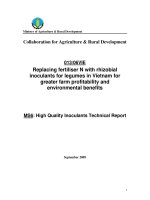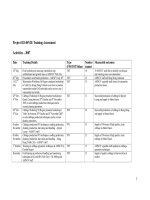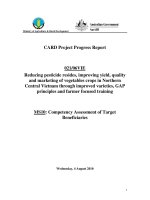Báo cáo khoa học nông nghiệp " LESSONS LEARNT ON PARTICIPATORY FOREST LAND ALLOCATION IN QUANG NGAI PROVINCE " ppt
Bạn đang xem bản rút gọn của tài liệu. Xem và tải ngay bản đầy đủ của tài liệu tại đây (1.34 MB, 37 trang )
WORKSHOP
WORKSHOP
LESSONS LEARNT ON PARTICIPATORY
FOREST LAND ALLOCATION IN QUANG
NGAI PROVINCE
In troduction
Participatory forest land allocation in Quang Ngai
province
Presenter: Phạm Đình Phong
Vicve head o
f
Land Administration Dept.
DARD Quảng Ngãi
Induction:
Rural Development program of Quang
(RUDEP) started in 2002 funded by AusAID;
In 2005, The participatory forest land
aloocation protocal initiated by the project have
been piloted in 2 communes.
In 2006, this protocal have been applied in 13
comunes of 8 districts of Quang Ngai.
Following the Resolution by the Provincial Party
Committee and the Provincial People’s Council that
mapping and issuance of forest Land Ownership Certificates
(LOC) in the six upland districts, DoNRE in coordination
with the District People’s Committees (DPCs) prepared the
Economic-Technical Reports (E-T Reports) on mapping for
preparation of cadastral maps of scale 1/5000, land
allocation, land registration, preparation of cadastral
documents and issuance of LOCs for forest land and other
sloping lands for annual tree crop production. The
Economic-Technical Report was prepared following the
seven Steps of PFLAP. The Steps are briefly shown in
Appendix 1. PFLAP was commenced in 2005 with the pilot
testing in two communes.
z Objectives:
+ Effective and sustainable use of forest resources
based on the sustainable protection, re
g
eneration,
and socilization of forest enterprises to ensure the
forest lands have owners.
+ Creates more jobs to improved living standards
of mountainous peoples to contribute to social
economic development, environemnt protection,
effective forest resources use.
+ Promote the participation of related
organizations, especially the poors, ethnic
minority groups in forest land allocation.
Implemenation
Implemenation
and results
and results
Village meeting to raise awareness of local
community (first meeting).
- Each village organized a meeting with the
participation of 60-70 peoples.
-Main contents of the meeting:
+
inform households on the national and provincial
policies related to forest land allocation and issuance of
land ownership certificates;
+ introduce households to PFLAP and schedules
for PFLAP implementation at the provincial,
district and commune level;
+ introduce households to forest land types,
regulations on their use and opportunities for
households to use and manage their land;
+ ensure that the households understand the
objectives, principles, and significance of land use
planning and land allocation activities and that
they can identify their roles and duties in land use
planning and land allocation process;
+ introduce households to concepts, signs,
colours, and the ways to identify boundaries and
place names on the current three forest-type
maps and exercises to identify current land use
practices.
Second village meeting on PFLAP
+ The second meeting was conduced to discuss and
propose a forest land use plan. The meeting was
conducted with the application of PRA tools to
discuss land use planning, and land use and
management plans.
z+ Criteria for forest land use:
the areas planned for protection, production,
cultivation, or afforestation were introduced to
the households using the topographical map
(1/5,000 scale). Discussions also included the
future forest land use strategies. .
The District Working Group (DWG) then worked
with households to identify future land use
activities for various forest land types.
Draft of the forest land use planning was prepared
as follows:
z The DWG in coordination with the consultants entered the
information in the future land use planning and boundaries into
the 1/10,000 scale topographical map. This map included land use
planning details and proposed land allocation plans agreed by
participants at the village meeting.
z The forest land area and planned area of different land types for
each village were calculated and entered into an inventory sheet.
Commune land use planning maps were an aggregation of village
planning maps and data.
z On the basis of these maps, the DWG assisted the Commune
People’s Committees (CPCs) in drafting the commune
participatory forest land use planning and land allocation plans.
- Worshop to consolidate the commune Forest Use Plan
z + The DWG presented the draft commune forest land
use planning and land allocation plans to the Commune
Land Advisory Council (CLAC).
z Recommendations and comments were given by
participants at the meeting to finalise the explanation of
the commune forest land use planning and land
allocation plans, maps and other relevant documents.
z The DWG assisted the CPCs to finalise the plans to
submit to the District People’s Committees (DPCs) for
approval.
z Altogether, there were 1,040 commune and village
meetings with the participation of 58,539 person times.
This included:
– Commune meetings (2 meetings/commune): 102
meetings; 4,189 person times
– Village meetings (2 meetings/village): 938 meetings; 54,350
person times
Results of mapping and Land ownership certificate
(LOC) – Red books
After two years (2007-2008) of the
implementation of mapping for preparation of
cadastral maps and issuance of land ownership
certificates in the six upland districts in Quang
Ngai, 121,930 Ha./124,138 Ha. of land was
measured, accounting for 98%, and 111,909
LOCs were delivered, accounting for 117% as
compared to the Economic-Technical Reports.
LOCs are jointly owned by both male and female
heads of the households.
In order to complete mapping and issuance of the
LOCs, DoNRE with the support of Institutional
Support Program (ISP) covered:
z Trainings to provide guidance on approval work
to the CLAC;
z Preparation for the village meeting and
consolidation of the proposals;
z Village meetings;
z CLAC meetings;
z District Steering Committee (SC) meetings and
z Trainings on the use of ViLis software.
By June 2009, total area measured for the
preparation of cadastral maps was 122,647 Ha.
with the issuance of 117,616 LOCs.
Pictures of awareness raising program
Implemetation
Implemetation
at district
at district
Traings
Traings
for working groups and land use
for working groups and land use
consutation
consutation
council
council
Training on use of GPS
Training on use of GPS
Implementing at commune
Implementing at commune
First village meeting
First village meeting
Participatory forest land allocation at
Participatory forest land allocation at
commune
commune
Training on assessment of
Training on assessment of
curent
curent
land use
land use
status
status
Second village meeting
Second village meeting
Presentation
of
forest
land
allocation
plan
Presentation
of
forest
land
allocation
plan
at commune (out door)
at commune (out door)









